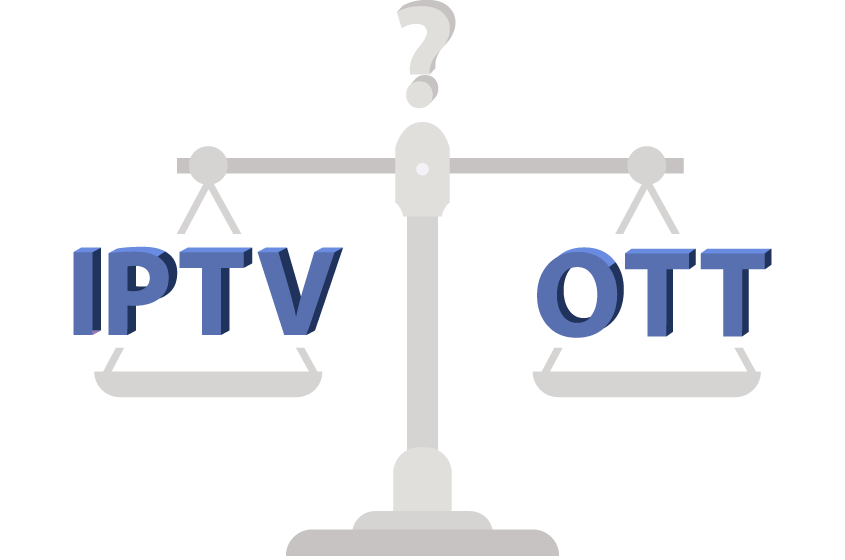Product request
You are looking for a solution:
Select an option, and we will develop the best offer
for you
HOW TO LAUNCH AN IPTV/OTT BUSINESS
“To ensure the timely launch of an IPTV/OTT project, it is important that you choose a comprehensive solution from a reliable partner. The main criteria here are whether the solution meets the market demand, will be profitable and will enable a service with high enough SLA. It’s all true for middleware, set-top boxes, and apps alike.
What makes an operator stand out is the quality of their services and client satisfaction, the technological head start is a very short-lived thing. You are better off launching MVPs. Imperfect as they are, they will still capture a market share. ”
Alexei Munteanu, former Vice President, Starnet

Who launches IPTV businesses now? And why?
IPTV is a part of the natural evolution from broadcasting to multiplay. Internet providers, cable and satellite companies—they all have their reasons to migrate.
Although subscribers were content with paying for just one service 15–16 years ago, it is no longer the case. To stay competitive, operators need to offer service packages: cable providers integrate IPTV, and most Internet providers now offer television. Service bundling started with Double Play that included Internet and TV. The next step was Triple Play, which added telephony to the package. Present-day mobile telephone operators have added a fourth component into the mix — mobile Internet — thus transitioning to the Quad Play model.
Amid tough competition, they have to combine services and become multiservice operators. As soon as one of the players starts offering multiple services, the offer with the best value gets him all the audience. A company like that has lower infrastructure amortization costs, as well as, costs of every service in the existing OPEX model since less staff is required to support a new service.
Who has an easier time integrating IPTV?
It's easiest for internet providers. They will need a head-end station, an antenna field, servers, and transcoders, and then there's the billing system that needs to be integrated and middleware to be deployed. The operator's LAN cable is in every household already, and chances are there's a Wi-Fi router there, too. So, subscribers purchase a set-top box or a service accessed through their Smart TV.
Cable operators can't transition to IPTV because their network does not support IP packets. The technology has already reached its ceiling—although one indeed can bring the cable services to a new level, it's just an imitation of IPTV. It's just a short-term strategy. In the age of personalized content and increasing customer expectations regarding quality, it's bound to reach another ceiling, and then there's no way through it. As Craig Charles once said, cable operators need to “evolve or die”. It's all up to them. The only happy ending here is through a merger or takeover.
The situation with HFC networks is somewhat more optimistic. The signal between large neighborhoods is transferred via fiber-optic cables, and digital is converted to analog once it enters the household. Operators like these have an easier time transitioning to IPTV. DOCSIS technology is optimal for them—in revision 4.0 it supports symmetrical channels with speeds up to 10 GBit/s, and it's just what you need for IPTV.
There is no market where cable would maintain presence after a multiplay operator has entered. Often, major players just take over these companies.
Do IPTV operators need to migrate to OTT?

To broadcast to mobile devices and smart TVs, IPTV operators need a hybrid platform and branded apps. The last mile between the device and the network has physically changed. Before, set-top boxes were connected to the network with a physical cable. Users were willing to lay cables all around the house, fixed to the walls, and hide wires under the skirting boards. Now they buy smart TVs with Wi-Fi, Netflix, YouTube, Amazon, and Hulu. The question is, why would you need a separate set-top box in this case? Content delivery methods are changing, so regular operators are getting closer to “over the top”.
In cities with high-rise buildings, there's a router in every flat. Some people keep their routers in wardrobes, on the floor or near the flat entrance and get a weak signal when they want to connect. But even if this problem is solved, you can't have clients on separate channels like 1, 6, and 11, or at least 1, 5, 9, 13. There's also interference with other routers and Bluetooth devices to consider. It's extremely difficult to manage wireless networks.
Operators can't guarantee that the last mile will be obstacle-free. Therefore, OTT is the last link in the chain, and you need new data management systems for access quality management.
How do you choose a solution and launch a project?
You need to go for what will help you make money. Multiscreen capabilities and support for a wide array of devices are also important—you need an open platform, wherein you can integrate different client devices.
Ask your solution supplier for a product roadmap. If there is none, the company just doesn't know where the market is moving and how its solution can be further developed. The Sales-driven development may not necessarily fit your company—especially if you have no influence on developers. If the operator knows nothing about middleware, it's their supplier who needs to have that expertise. If the supplier has a vision, the operator will remain competitive, too.
Which is better: mixed-and-matched services from different suppliers or a comprehensive solution?

Most often, operators have a CTO, but no CIO. The former is responsible for hardware and cables, and the latter for software. Without a CIO, companies can't develop their own solutions or improve on others' work. They want something that works out of the box. You are much better off trusting your middleware supplier or hiring an expert. There's no use in starting from scratch.
Operators rarely approach suppliers with a precise request. You need to educate such clients. A good middleware supplier will explain: “We work with transcoders of X brand, recommend affordable servers for storage and streaming from Y brand, and support billing and DRM solutions from brand Z.”
This is what integration companies are living off—they take the first company's middleware, streaming solutions from the second, servers from the third, and use them to build a complete solution for their client.
What earns operators money?
It's subscriptions. On average, the first 6–12 months’ worth of subscription fees go to recoup the last mile's cost. In Ukraine, where triple-play services are priced at about $8/month, a set-top box will cost you $50, a Wi-Fi router—$20, and a cheap cable—$6. Then add in the wiring technician wages and marketing costs—and you spend $100 just to attract a client. And we don't take into account the cost of content, interconnection (procuring internet), and network amortization.
Over the first year, operators recoup the cost of terminal and network equipment and don't make any profit until 6–12 months later. The net income margin under the obligatory contract period is around 10–20% and all the profits come from the next one, where you don't need to invest in the client (apart from marketing investments to extend the contract). This kind of model is healthy for telecom, there's no quick money here.

There are some limitations, too. Like, you can't sign a contract for a period of over 2 years in the EU. Similar legislation is also in place in the USA and some other countries. In Arab countries, you can't oblige anyone to use your services. It is frowned upon as promotion of debt, so it's consumption-based billing all the way.
If you do everything right, you'll have a client lifespan of 36–38 months in your prediction model. Then you use it to calculate your business model, keeping in mind that the market is not endless, and sifting through all the possible customers is not the right thing to do. It is important that you ensure a positive experience for your customers, strive to maximize the quality of service and to achieve higher NPS in the industry. In this case, the operator's business will show continuous growth.
Whether the client extends the contract will depend on the retention techniques you use. For instance, if someone signs a contract for two years with an operator, no one bothers them, but as soon as the expiration date approaches, the call center chimes in: “Hi, we have a special offer for you—we can offer you even better terms for the same price or even cheaper. All you have to do is extend your contract. Please, pay us a visit to sign the papers”. This is how competition often snatches your viewers, and so you need to build relationships with customers during those two years instead of leaving them alone until the contract expiration looms.
The relationship between companies and customers is akin to friendship. Hardly anyone would throw away a stable relationship and rush head-first into the unknown. We prefer to deal with those we know and those who are loyal to us. Imagine yourself in your customer's shoes: how disappointed would you be to have to replace all the cables in your home again?
How do you choose software and hardware providers?
You need to go by your business needs. How much money it will earn you? Does the system suit your business model? There are no fancy analysis techniques, “choose the best” is not always the best approach. Advanced solutions are for countries like Germany where 20 Mbit/s internet over ADSL 2+ costs EUR 17 per month. Triple Play is priced at EUR 40 or above there. If a viewer generates for you EUR 480 annually, you may want to spare no expense and even present them with a TV. You will recoup the price of your TV—EUR 360 and connection cost—EUR 100 over the first 12 months and reap profits over the following year.
It’s for markets like these that middleware suppliers create high-end solutions.
Choosing one for yourself, you need to think if it can help you run a competitive service with the SLA you need, if it will fit the market on the technical side of things, and if it will generate profit. If it won't, you'll have to look elsewhere. All those things are true for apps, middleware, and set-top boxes alike.
Selling their business, operators tend to forget about the capital cost and infrastructure quality. Expensive servers, antenna fields, and state-of-the-art network mean nothing for buyers, all they want to know is how much the business earns. No one says: “This company is making a loss, but they have one heck of a great piece of tech! We need to buy it.” All they are concerned about is money.

Should we pay extra for functionality?
It depends on how unique the functionality is. If it's easy to replicate, there's no need to pay for it. As I said, check the vendor's roadmap: chances are, someone's unique service is being replicated somewhere else already. There are no unique technologies, only temporary advantages. And it's a whole different question if you will be able to capitalize on them. Implementing innovation in telecom, you need to make an effort and sway the market. It takes a lot of money to make a new service known to everyone.
You will get a few new clients right off the bat, but others will come only in eight months or so. Your competition will use this time to launch something similar, but without having to educate the market.
Being a runner-up pays off in telecom. Only leaders are forced to experiment.
Leaders have the hardest time. Businesses divide the year into classic seasons. Christmas and Easter sales, summer special offers, and the back-to-school season. Leaders need to come up with a great value offer for consumers for every occasion. Often, we are talking about global operators, which have the resources it takes to create something unique.
The runner-up waits until their marketing department gets some kind of reference material in the form of a complete advertising campaign. When leaders launch a promotion, their sales department under the disguise of a buyer finds out its terms and prepares a commercial order. Marketing prepares a campaign, and in two weeks, a more attractive offer is launched. It's the typical behavior of runners-up.
How do you retain your audience and develop it too?

What makes an operator stand out is the quality of its services and client satisfaction, the technological head start is a very short-lived thing. Also, viewers need exciting content.
Open-access channels account for 50% (or even 70% in some countries) of TV viewership—it's national news-and-talk-show channels. Even in Moldova, just one channel has a share of 15%. Of 150 channels, only 30 are regularly watched. An average male watches local news, sports, films, fishing, and hunting. Adult content is also up there. In my experience, I saw multiple occasions where 70% of households switched to those particular channels’ viewership peaked in the evening. Adult content is a taboo—no one talks or asks about it, but it’s popular, people are willing to pay for it.
Netflix showed growth when it started shooting original shows. Want to shoot something cool—shoot it yourself. One of Bulgaria's national operators broadcasts 13 channels of its own, offering sports and local news coverage, as well as films. The company broadcasts all football, basketball, and volleyball matches—this is what sets it apart from the competition.
Recommended

How Distributors Can Use White-Label IPTV Set-Top Boxes in Partner Programs
The IPTV and OTT market is developing rapidly, opening new growth opportunities for distributors.

How to Test IPTV Apps Before Release: Recommendations for Operators
Before launching any large-scale IPTV service, it's critical to ensure that the platform operates reliably, performs well, and is free of critical bugs.

Content Mirroring and Backup Streams: How to Avoid the "Black Screen"
In the highly competitive IPTV/OTT market, every broadcast failure is more than just a technical glitch — it's a direct threat to viewer loyalty and an operator's reputation.











